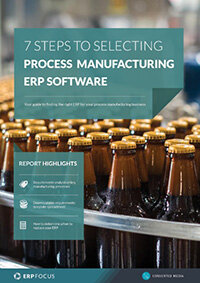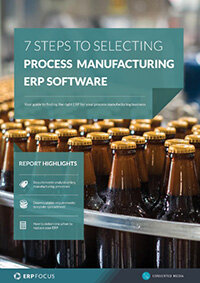Is your manufacturing operation intelligently using its data? BI can help
Big data, fast data, smart data––the global population is hungry for data, consuming it, analyzing it, and turning it out at an increasing rate. Business has always known that information is power. Having the right amount, right kind, and the right timing of data use can help position a process manufacturer more consistently as a leader in its particular industry. Is your manufacturing operation intelligently using its data to continuously improve? If your answer is, “no,” explore the empowering possibilities an investment in Business Intelligence (BI) provides, especially when it’s integrated with Enterprise Resource Planning (ERP) software.
Process manufacturers collect enormous amounts of data from any number of sources. For some, the information accumulates in departmental silos where it’s rarely (if ever) utilized. Company personnel are mystified about what types of data these disparate files hold or how to access this information, how to filter out superfluous data or how to frame a targeted query in a way that generates truly strategic answers. For all practical purposes, this data is dormant. Here’s where BI can make it easier for your process manufacturing business to use data to its advantage.
BI helps smart manufacturers translate raw data in ways that actually work for them. Thanks to intuitive interfaces, BI sorts, groups, filters, graphs, and dashboards historical and real-time data, animating it into meaningful information for analytical decision-making and reporting. Data is used to create and post customized reports, share with multiple users, drill-down to the transaction or record level, and filter or export on short notice. BI’s language is familiar, rendering tables, field names, screen prompts, menus, etc. readily understandable. In addition, interactive reports, graphs, and dashboards, with point-and-click and drag-and-drop features, are especially important for staff not educated in information technology (IT).
Organization-wide analytics use
With BI, your staff have the potential to use sophisticated data analysis every day, without diverting the attention of your IT and data analytics staff from their weightier responsibilities. BI offers state-of-the-art capabilities that are easily used by a diverse employee base, helping them streamline and improve performance as they reference browser-based analytics or answer ad hoc business questions. Employees effectively communicate with one another, sharing documents, spreadsheets, and interactive reports through leveraging data from one or many sources.
Recommended reading: process manufacturing ERP selection - 7 steps to success
Throughout the manufacturing operation, BI’s manipulation of data facilitates better business practices. Sales, operations, and management execute various analyses and reports and utilize departmental and cross-functional analyses to measure the company’s health per key performance indicators (KPI’s) such as Customer Profitability, On-time Delivery, Days in Quarantine, and Cost of Quality. BI also analyzes safety and compliance data for reporting to governmental agencies as well as for handling lot traceability to uncover problems or manage product recalls.
Data visualization to catch and hold attention
When integrated with ERP, BI provides your employees with the ability to: design customized, easy-to-use and understand dashboards with charts, graphs, and reports by using point-and-click and drag-and-drop tools. This allows for employees to quickly construct real-time financial and operational reports; drill-down to detailed data from anywhere in the database; export data and post reports to external systems, for wider sharing and timely collaboration. BI offers a simplified user experience that makes accessing, understanding, and interacting with important data visually appealing, instantaneous, and more agile for staff, strategic partners, and customers.
Centralized data from multiple sources
Process manufacturers collect data from multiple sources via various devices. This data is used for critical decision-making across a broad spectrum of management activities––production planning, product lifecycle, inventory control, warehousing, quality control, supply chain, customer relationships, marketing, and sales. A modern business needs to consolidate this information into a centralized database that can be accessed readily by many users who can pare the data down into workable portions for consideration. BI, when coupled with ERP, allows you to pull and seamlessly share data between departments as well as externally from geographically remote sites, supply chain partners, or customers through self-serve, shared portals.
With BI, your staff have the potential to use sophisticated data analysis every day, without diverting the attention of your IT and data analytics staff from their weightier responsibilities.
According to a recent study by International Data Group (IDG), 36% of respondent organizations plan to increase their budgets for data-focused initiatives in 2015, and 63% of small and medium businesses (SMBs) and 80% of enterprises have launched, or plan to launch, Big Data projects within a year. Enterprise organizations will invest $13.8M on data-driven initiatives, while SMBs will invest $1.6M, concludes IDG.2. IDG also predicts that spending on Big Data analytics will grow three times faster in 2015 than it did in 2014, bringing the market to $125 billion worldwide.3. Forward thinking companies are committed to mining, and harnessing the plenty awaiting in their databases.
A process manufacturer committed to using its existing data more effectively to enhance efficiencies and increase productivity and profits would be wise to follow the growing trend toward investing in the mining and using of smart data. An investment in BI functionality, integrated within an ERP software solution, would be an intelligent choice.
Free white paper

7 Steps to Selecting Process Manufacturing ERP
Your guide to finding the right ERP software for your process manufacturing business

Featured white papers
-

7 Steps to Selecting Process Manufacturing ERP
Your guide to finding the right ERP software for your process manufacturing business
Download
Related articles
-

Process manufacturing ERP: formulas and recipes
Find out about the challenges your process manufacturing ERP will face when it comes to recipes a...
-

CMMC Compliance: What Aerospace and Defense Manufacturers Need to Know
Key insights on CMMC compliance, deadlines, and securing DoD contracts with CMMC 2.0 certificatio...
-

Solving the deals and rebates challenge in your food ERP system
How selecting the right technology partner can give food distribution companies a competitive edge

